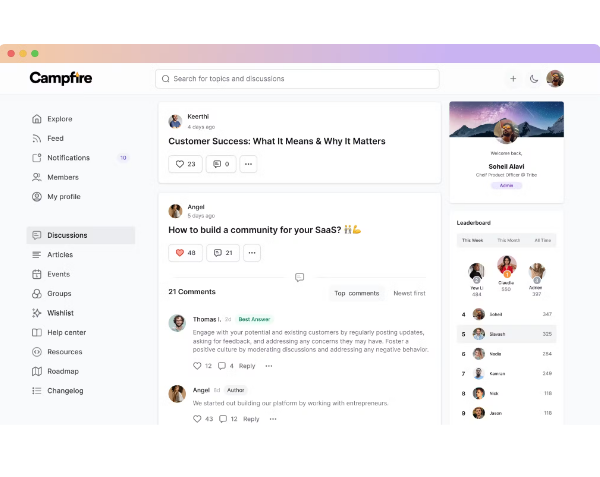Measuring Community ROI: Growth Metrics That Matter for Business

Building strong, engaged communities is more than just a trend – it's a critical driver of success. However, many organizations face challenges when it comes to measuring the true value of their community initiatives.
By focusing on key indicators like engagement, retention, and customer satisfaction, you can unlock the full potential of your community efforts and maximize their return. This article delves into the growth metrics that matter most for businesses, offering a comprehensive guide on tracking and quantifying community impact.
What is growth metrics?
Growth metrics measure the expansion and progress of a community, business or platform over time. In the context of an online community, growth metrics focus on tracking the size, activity and engagement levels of the community, as well as how these factors evolve. They help community managers understand whether their efforts successfully attract new members, retain existing ones, and foster sustained interaction.
Types of growth metrics to measure for business success
Growth metrics are crucial for measuring business success, as they provide insights into how well a company is scaling, attracting customers and increasing revenue. These metrics can track performance across various areas such as customer acquisition, revenue generation and market share.
Below are key types of growth metrics businesses should monitor to ensure success:
Conversion rate
Conversion rate is the percentage of users or potential customers who take a desired action, such as making a purchase, signing up for a service or completing a form. It measures how effectively a business is turning website visitors or prospects into actual subscribers.
Community activities, such as discussions, user-generated content or peer reviews can significantly impact conversion rates by influencing purchasing decisions. A highly engaged community fosters trust and social proof, which can encourage visitors to convert into paying customers.
Customer acquisition cost

Customer acquisition refers to the various steps and strategies a company uses to gain new customers. It generally involves convincing the customer to purchase a product or service.
Customer acquisition cost (CAC) is the total amount of money required to bring in a new customer. Monitoring CAC helps asses the efficiency of sales efforts and the performance of the acquisition process. It also plays a key role in determining the return on investment for each customer gained.
A strong, active community can reduce customer acquisition costs. Organic engagement, word-of-mouth marketing and community referrals lower the need for paid advertising and traditional marketing efforts.
Customer retention rate
Customer retention rate measures the percentage of existing customers who continue to do business with your company over a specific period. It provides insight into what keeps customers loyal and can highlight areas for enhancing customer service. When you understand how effectively your company retains customers, you can identify opportunities to improve and increase your retention rate.
Communities can enhance customer loyalty and retention of existing customers by providing a space for ongoing support, product feedback and deeper brand relationships.
Churn rate
Churn rate, also called attrition rate, refers to the percentage of customers who stop doing business with a company within a given time frame. This metric can also apply to subscribers who cancel or choose not to renew their subscriptions. A higher churn rate indicates more customers are leaving, while a lower churn rate means more customers are staying. Generally, a lower churn rate is preferred, as it reflects better customer retention.
A well-engaged community can reduce churn by offering customers a reason to stay connected with the brand, beyond just using the product. If a community provides value through support, resources or social connection, customers may be less likely to leave.
Customer satisfaction
Customer satisfaction is a measure of how well a company's products, services or overall experience meet or exceed the expectations of its customers. It reflects the degree to which customers are content with their interactions and transactions with a business. High levels of customer satisfaction often lead to customer loyalty, repeat business and positive word-of-mouth referrals.
Community interaction often enhances customer satisfaction by offering peer-to-peer support, quick answers to questions, and a sense of belonging.
Customer feedback

Customer feedback is the information provided by your customers regarding the quality of your product, customer service, or any interactions with your company. It centers on meeting customer needs and expectations.
Some examples of customer feedback are:
- Sales or customer success feedback
- Customer service feedback
- Support ticket spikes
- Social media posts
- Comments
- Reviews
- Surveys
- Returns
Communities are an invaluable resource for gathering real-time customer feedback.
You can monitor the feedback provided within community spaces, forums, and social threads to better understand user concerns, desires, and product suggestions. This input can be used to improve products and services, driving higher satisfaction and innovation.
Market share
Market share is the percentage of an industry's sales that a particular company or product controls within a specific market. It is a key indicator of a company's competitiveness and its relative size in the market compared to its competitors.
Market share is a crucial metric for evaluating a company's performance within its industry. Monitoring market share can help businesses adapt to changes in the market, enhance competitiveness and identify areas for growth.
An active community can help increase a company’s market share by fostering brand community loyalty, advocacy, and word-of-mouth marketing. The reach and influence of the community can enhance the brand's reputation in the market, contributing to a larger customer base.
ROI
Return on Investment (ROI) is a financial metric used to evaluate the profitability and efficiency of an investment. It measures the return generated on an investment relative to its cost, allowing businesses and investors to assess the effectiveness of their financial decisions.
Communities can directly contribute to ROI by reducing support costs, improving customer loyalty and increasing sales.
Sales revenue

Sales revenue is the income generated from the sale of goods or services by a business over a specific period. It represents the total amount of money received or expected to be received from customers in exchange for products or services before any expenses are deducted.
An engaged community can boost sales revenue by fostering product discovery, upselling, and cross-selling opportunities. For instance, communities may promote new product launches or special offers that drive additional sales.
Gross and net profit margin
Gross profit margin and net profit margin are two important financial metrics that help businesses assess their profitability at different stages of their operations.
Gross profit margin measures the percentage of revenue that exceeds the cost of goods sold (COGS). It indicates how efficiently a company produces its goods and how much profit it makes after covering the direct costs associated with production.
Net profit margin measures the percentage of revenue that remains as profit after all expenses, including operating costs, taxes, interest, and other expenses, have been deducted. It provides a comprehensive view of a company’s overall profitability.
Community initiatives can improve both gross and net profit margins by driving customer acquisition at a lower cost and increasing retention, leading to more repeat sales. Additionally, communities reduce the need for extensive customer support or marketing budgets, lowering operational expenses.
How can Bettermode help measure your community growth metrics?

Building strong, engaged communities is no longer just a marketing strategy – it's a key driver of business growth. Bettermode is a platform that helps businesses track and optimize community growth by providing tools to measure vital metrics such as customer engagement and the business impact of communities.
The community platform also supports companies in tracking the engagement revenue correlation and other key performance indicators (KPIs) that directly contribute to measuring community ROI.
Here's how Bettermode can help you measure your community growth metrics:
Creating a dynamic community protal for customer interaction
Businesses can use Bettermode to build a comprehensive community portal where users can interact, share experiences and support one another. This central hub helps businesses track community success metrics such as:
- active users
- engagement levels
- new member growth
By analyzing these metrics, companies can evaluate the overall health and effectiveness of the community in driving customer retention and satisfaction. It also lets them measure the business impact of communities in terms of customer loyalty and brand advocacy.
Leveraging a customer support forum for enhanced engagement
Setting up a customer support forum through Bettermode can be a cost-effective way to reduce reliance on traditional support teams. Customers can solve problems collaboratively, lowering support costs while improving overall satisfaction.
Bettermode tracks community contribution to sales by analyzing:
- how quickly issues are resolved in the forum
- how many support tickets are avoided
- and how these interactions convert into sales or upgrades
This direct link between engagement and outcomes helps businesses measure the ROI of customer advocacy.
Fostering a media brand community for customer engagement
For digital content creators and media companies, building a media brand community is crucial for fostering customer engagement. Bettermode helps track how actively users engage with content, share resources, and interact with other members.
The platform provides tools for tracking community performance benchmarks such as:
- the number of content shares
- referral rates
- and user-generated content
These metrics help businesses measure the engagement to revenue correlation, demonstrating how active community members contribute to revenue growth.
Enhancing self-service with knowledge base software
Bettermode’s integration with knowledge base software allows businesses to build a repository of FAQs, tutorials and troubleshooting guides. Measuring the community contribution to sales can be done by tracking how often customers use the knowledge base to make informed purchasing decisions. By reviewing the number of queries and searches resolved through the community’s knowledge base, businesses can also track a community health scorecard, evaluating how well the community serves as a self-sustaining support ecosystem.
Building a customer service community to boost retention
Bettermode makes it easy to create a customer service community where customers can provide peer-to-peer support and share solutions. It reduces the need for traditional customer service channels and improves retention.
Businesses can track retention metrics in communities to measure how participation in customer service discussions helps improve customer lifetime value and reduces churn. High retention rates and customer satisfaction scores within the community are indicators of long-term business growth.
Optimizing customer assistance through a help center platform
A help center platform integrated with Bettermode can streamline the customer support process, letting customers find answers quickly. By tracking usage metrics, businesses can measure how effectively the help center resolves issues.
Moreover, metrics like time-to-resolution and frequent queries can be tied to broader community performance benchmarks, helping businesses fine-tune their customer service approach. Successful usage of the help center can also increase the customer lifetime value in communities by reducing frustration and improving customer satisfaction.
Revitalizing community engagement for long-term success
Keeping a community active and engaged requires constant effort. Bettermode provides the tools to help businesses focus on revitalizing community engagement through campaigns, events and content.
By monitoring metrics such as
- activity rates
- post contributions
- and event participation
businesses can ensure sustained growth. This, in turn, contributes to the ROI of customer advocacy by maintaining an active group of brand advocates who promote the product or service to new users, boosting both engagement and sales.
Collecting customer feedback to improve the community value
Businesses can use Bettermode's platform to facilitate collecting customer feedback through community-driven surveys, polls and discussions. This feedback is invaluable for improving products, services and community experiences.
By monitoring feedback trends, companies can adjust their community strategies and align them with customer expectations.
Showing community member appreciation for increased retention
Recognizing and rewarding active community participants can significantly increase engagement and retention. Bettermode offers features that highlight community member appreciation through
- rewards programs
- gamification
- and public recognition of top contributors
By tracking how these appreciation initiatives influence member activity, businesses can see direct improvements in their retention metrics in communities, which ultimately enhances long-term business success and customer loyalty.
Adapting to customer support trends in SaaS communities
Bettermode lets businesses monitor how their SaaS community responds to changing customer expectations. By tracking common support issues, emerging product requests and engagement trends within the community, businesses can stay ahead of customer support trends in SaaS.
This proactive approach helps companies refine their support strategies, ensuring that the community contributes to reducing churn and increasing customer lifetime value.
Conclusion
Building and nurturing a strong, engaged community is essential for long-term business success. But to unlock its full potential, the value of the community must be effectively measured. That's why businesses should focus on key business growth metrics. It can give them critical insights into their initiatives and how they drive business objectives.
Bettermode provides tools needed to monitor these metrics, offering deep insights and actionable data to help you continuously improve your community strategies and maximize return on investment.
Ready to unlock the full potential of your community? Book a demo with Bettermode and see how our platform can help you track key growth metrics, boost engagement and enhance customer retention – all in one place.

FAQs
What are the growth metrics?
Growth metrics are key indicators to measure and track the expansion and performance of a business over time. These metrics help companies evaluate how well they are scaling, attracting customers and improving profitability. Some essential growth metrics include:
- Revenue growth rate
- Customer lifetime value (CLV)
- Customer churn rate
- Monthly recurring revenue (MRR) and annual recurring revenue (ARR)
- Average revenue per customer
- Business performance and community engagement
- Revenue generated from community members
- Retention rate
How do you calculate growth metrics?
Calculating growth metrics involves using specific formulas to track performance and expansion over time. Each growth metric has a unique formula and methodology based on the aspect of growth you're measuring (e.g., revenue, users, customers, or profits).
For example, to calculate revenue growth rate, follow these steps:
- Identify the revenue for the current period and the previous period (e.g., month, quarter, or year).
- Subtract the previous period’s revenue from the current period’s revenue.
- Divide the result by the previous period’s revenue.
- Multiply by 100 to get the percentage.
What is KPI in growth?
In the context of growth, KPIs (Key Performance Indicators) are specific, measurable metrics that track and evaluate the success of a business’s growth strategies. KPIs help businesses focus on key areas such as revenue, customer acquisition, retention, product usage, and market expansion.
Growth KPIs are essential for understanding how well a company is performing in terms of scaling, reaching new customers, and improving profitability. Some essential KPIs for tracking business growth include revenue growth rate, customer acquisition cost and customer lifetime value.
How do you measure performance growth?
Measuring performance growth involves tracking specific metrics and KPIs (Key Performance Indicators) that indicate how well a company, product, or service is growing over time. By focusing on key areas such as financial performance, customer acquisition, product usage, and market expansion, businesses can gain valuable insights into their growth trajectory.
Here are steps and strategies to measure performance growth effectively:
- Set clear goals and benchmarks
- Track revenue growth metrics
- Monitor customer growth metrics
- Analyze user or product engagement metrics
- Measure marketing effectiveness and ROI
- Asses operational efficiency metrics





